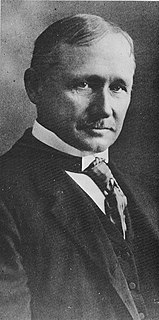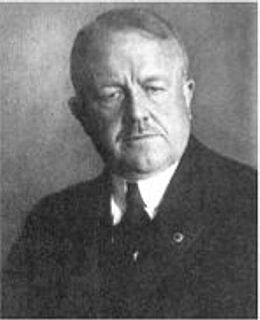Related Research Articles

Lillian Evelyn Gilbreth was an American psychologist, industrial engineer, consultant, and educator who was an early pioneer in applying psychology to time-and-motion studies. She was described in the 1940s as "a genius in the art of living." Gilbreth, one of the first female engineers to earn a Ph.D., is considered to be the first industrial/organizational psychologist. She and her husband, Frank Bunker Gilbreth, were efficiency experts who contributed to the study of industrial engineering, especially in the areas of motion study and human factors. Cheaper by the Dozen (1948) and Belles on Their Toes (1950), written by two of their children tell the story of their family life and describe how time-and-motion studies were applied to the organization and daily activities of their large family. Both books were later made into feature films.

Frederick Winslow Taylor was an American mechanical engineer. He was widely known for his methods to improve industrial efficiency. He was one of the first management consultants. In 1911, Taylor summed up his efficiency techniques in his book The Principles of Scientific Management which, in 2001, Fellows of the Academy of Management voted the most influential management book of the twentieth century. His pioneering work in applying engineering principles to the work done on the factory floor was instrumental in the creation and development of the branch of engineering that is now known as industrial engineering. Taylor made his name, and was most proud of his work, in scientific management; however, he made his fortune patenting steel-process improvements. As a result, Scientific management is sometimes referred to as Taylorism.

Scientific management is a theory of management that analyzes and synthesizes workflows. Its main objective is improving economic efficiency, especially labor productivity. It was one of the earliest attempts to apply science to the engineering of processes to management. Scientific management is sometimes known as Taylorism after its pioneer, Frederick Winslow Taylor.
Therbligs are 18 kinds of elemental motions, used in the study of motion economy in the workplace. A workplace task is analyzed by recording each of the therblig units for a process, with the results used for optimization of manual labour by eliminating unneeded movements.

A flowchart is a type of diagram that represents a workflow or process. A flowchart can also be defined as a diagrammatic representation of an algorithm, a step-by-step approach to solving a task.

Frank Bunker Gilbreth was an American engineer, consultant, and author known as an early advocate of scientific management and a pioneer of time and motion study, and is perhaps best known as the father and central figure of Cheaper by the Dozen.

A time and motion study is a business efficiency technique combining the Time Study work of Frederick Winslow Taylor with the Motion Study work of Frank and Lillian Gilbreth. It is a major part of scientific management (Taylorism). After its first introduction, time study developed in the direction of establishing standard times, while motion study evolved into a technique for improving work methods. The two techniques became integrated and refined into a widely accepted method applicable to the improvement and upgrading of work systems. This integrated approach to work system improvement is known as methods engineering and it is applied today to industrial as well as service organizations, including banks, schools and hospitals.

Operations management is an area of management concerned with designing and controlling the process of production and redesigning business operations in the production of goods or services. It involves the responsibility of ensuring that business operations are efficient in terms of using as few resources as needed and effective in meeting customer requirements.
Business process mapping refers to activities involved in defining what a business entity does, who is responsible, to what standard a business process should be completed, and how the success of a business process can be determined.
Benjamin S. Graham, Sr. (1900–1960) was an American organizational theorist and consultant known as a pioneer in the development and application of scientific management and industrial engineering techniques to the office and factory clerical work. He is recognized as the founder of paperwork simplification. He saw a growing need for improvement in information processing back in the 1940s.
The Psychology of Management: The Function of the Mind in Determining, Teaching, and Installing Methods of Least Waste is a book written by Lillian Gilbreth which investigates the psychological aspects of scientific management, incorporating concepts of human relations and worker individuality into management principles. Published in 1914, it is a major early work in the field of industrial psychology and scientific management. A contemporary book review reflects early resistance to scientific management, stating the book "does not answer the really important questions about the effect of standardized work upon the worker".
Richard Muther was an American consulting engineer, faculty member at MIT, and author. He developed fundamental techniques used in plant layout, material handling, and other aspects of industrial engineering. He was also known as "Mister Systematic".

A functional flow block diagram (FFBD) is a multi-tier, time-sequenced, step-by-step flow diagram of a system’s functional flow. The term "functional" in this context is different from its use in functional programming or in mathematics, where pairing "functional" with "flow" would be ambiguous. Here, "functional flow" pertains to the sequencing of operations, with "flow" arrows expressing dependence on the success of prior operations. FFBDs may also express input and output data dependencies between functional blocks, as shown in figures below, but FFBDs primarily focus on sequencing.

Industrial Engineering is an engineering profession that is concerned with the optimization of complex processes, systems, or organizations by developing, improving and implementing integrated systems of people, money, knowledge, information and equipment. Industrial engineering is central to manufacturing operations.

The flow process chart is a graphical and symbolic representation of the activities performed on the work piece during the operation in industrial engineering.
Industrial and production engineering (IPE) is an interdisciplinary engineering discipline that includes manufacturing technology, engineering sciences, management science, and optimization of complex processes, systems, or organizations. It is concerned with the understanding and application of engineering procedures in manufacturing processes and production methods. Industrial engineering dates back all the way to the industrial revolution, initiated in 1700s by Sir Adam Smith, Henry Ford, Eli Whitney, Frank Gilbreth and Lilian Gilbreth, Henry Gantt, F.W. Taylor, etc. After the 1970s, industrial and production engineering developed worldwide and started to widely use automation and robotics. Industrial and production engineering includes three areas: Mechanical engineering, industrial engineering, and management science.

The Taylor Society was an American society for the discussion and promotion of scientific management, named after Frederick Winslow Taylor.

Harold Bright Maynard was an American industrial engineer, consulting engineer at the Methods Engineering Council, and management author. He is known as the "Broadway counsel for industries, railroads, state governments" and as recipient of the Henry Laurence Gantt Medal in 1964.
The Gilbreth Medal is a former management award (1931–2002) for outstanding contributions to Industrial Engineering, established in 1931 by the Society of Industrial Engineers in honor of Frank Bunker Gilbreth Sr.
References
- ↑ Factory management and maintenance (1958) Vol. 116, Nr. 7-9. p.179
- ↑ Association of School Business Officials of the United States and Canada (1959) Proceedings. p.192
- ↑ Allan H. Mogensen, Rosario Rausa (1989) Mogy: an autobiography : "father of work simplification".
- 1 2 3 4 5 Ben B. Graham (2004) Detail Process Charting: Speaking the Language of Process New Jersey : Wiley.
- ↑ John William Leonard, William Frederick Mohr, Herman Warren Knox. Who's who in New York City and State. Volume 11. 1947. p. 733
- ↑ Ken Hopper, Will Hopper (2007) The Puritan Gift: Triumph, Collapse and Revival of an American Dream. p.78
- ↑ Steven C. Stryker (2011) Principles and Practices of Professional Consulting. p.10
- ↑ National Office Management Association (1951) Nomayear (1951) Nr. 32, p.25
- ↑ George Worthington (1965) Factory. Vol 123. p. 115
- ↑ Ralph Mosser Barnes (1980) Motion and time study: design and measurement of work. p.523
- ↑ Suman Chopra (2002) Improvement Techniques In. p.173
- ↑ Ben S. Graham (1950) Paperwork simplification Archived 2012-04-25 at the Wayback Machine . Paper presented to Industrial Management Institute, May 17–18, 1950
- ↑ Popular Mechanics. Sept 1941. Vol. 76, nr. 3 p.40
- ↑ Society for Advancement of Management, S.A.M. Advanced Management Journal, Volumes 47-48. 1982. p. 33